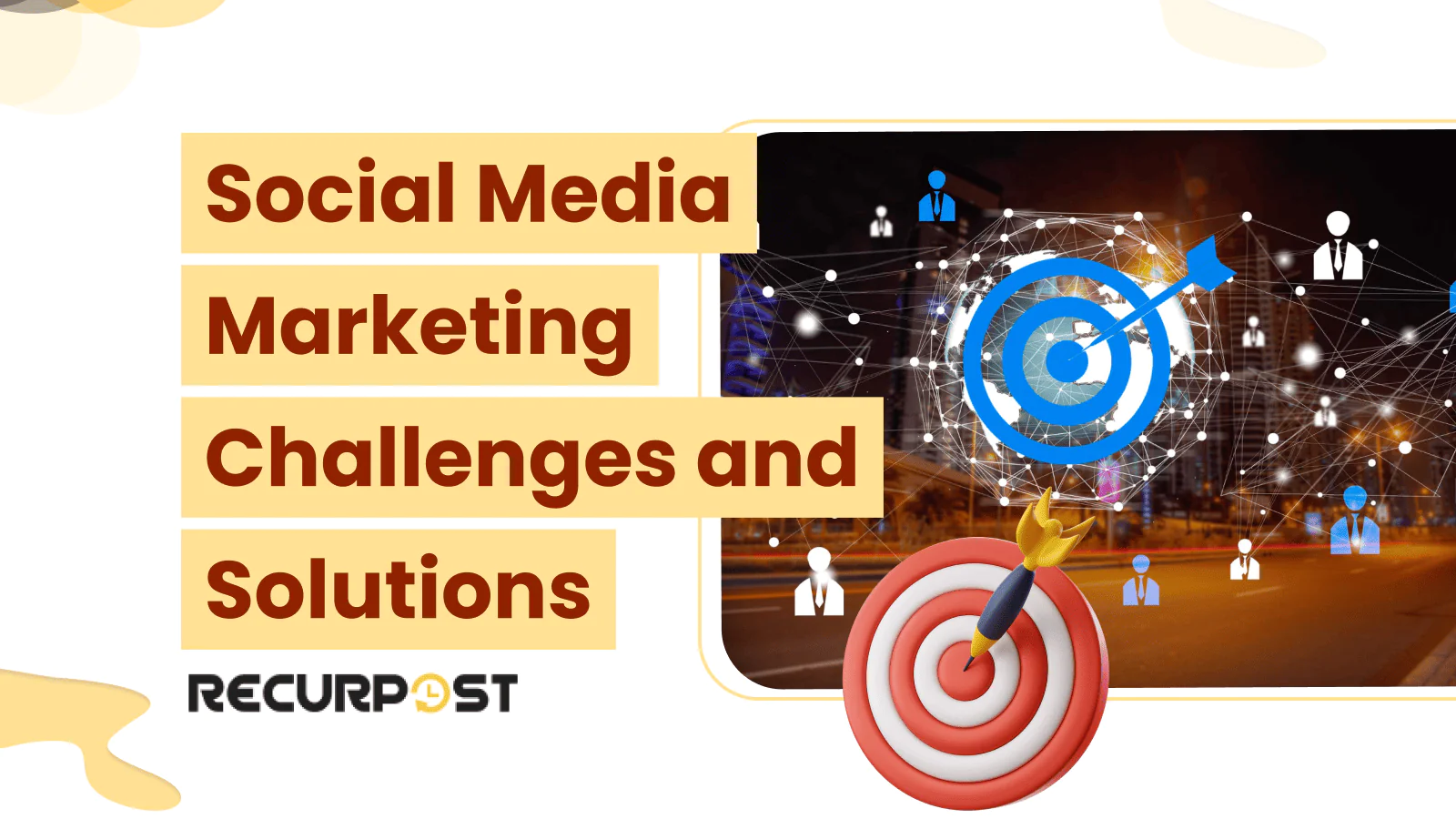Social media has become a major platform for marketing. As of 2025, there are over 5.24 billion active social media users worldwide. That’s a huge audience, and it’s one that businesses are increasingly turning to in order to connect with their target audience. But while social platforms like Instagram, Facebook, TikTok, and LinkedIn offer massive potential for brand growth, they also come with their own set of challenges that can make marketing feel a little more like a maze than a clear path.
So, why is this more important now than ever? In an age where algorithm changes, privacy regulations, and shifting user behavior are the norms, businesses must adapt quickly or risk losing relevance. Social media marketing challenges aren’t just a nuisance; they can seriously impact how your brand interacts with customers and how successful your campaigns will be.
This article covers the top social media marketing challenges businesses face today. From platform-specific issues to struggles with measuring ROI and adapting to new technologies, the following sections break down these obstacles and provide practical solutions. Whether you’re trying to boost engagement or improve your social media efforts, the following solutions can help.
Platform-Specific Social Media Marketing Challenges
1. Facebook Advertising Challenges
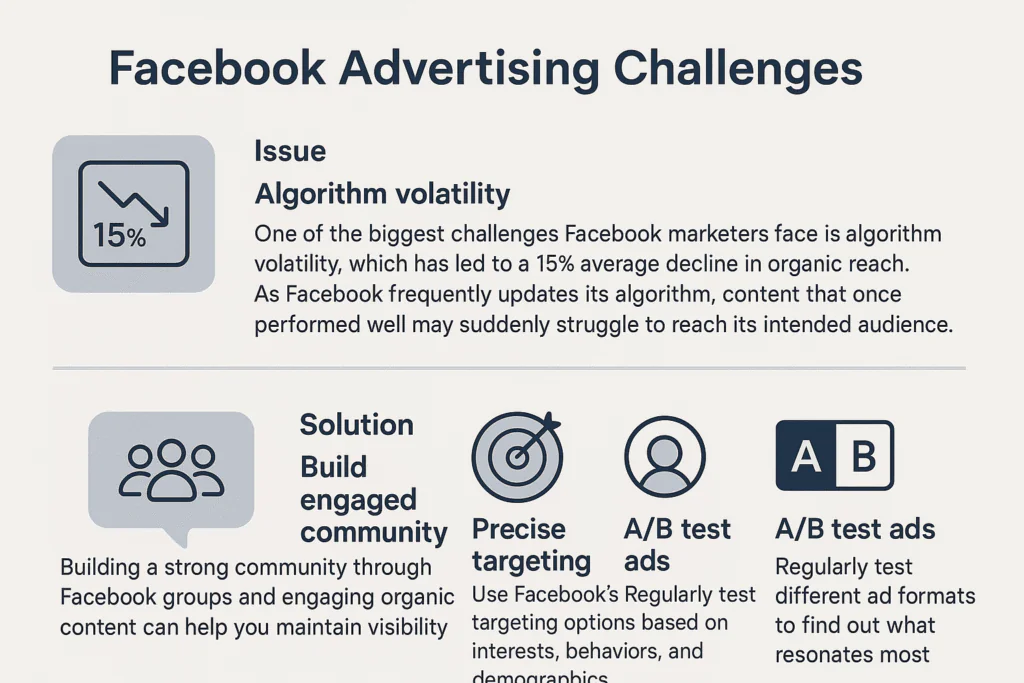
Issue:
One of the biggest challenges Facebook marketers face is algorithm volatility, which has led to a 15% average decline in organic reach. As Facebook frequently updates its algorithm, content that once performed well may suddenly struggle to reach its intended audience. This change can feel frustrating for businesses that have come to rely on organic posts to engage with their followers.
Solution:
To counter these shifts, it’s important to shift focus to building a more engaged community. Building a strong community through Facebook groups and engaging organic content can help you maintain visibility and keep your audience engaged despite algorithm changes.
Another way to adjust is by using precise audience targeting. Facebook offers powerful tools that let you target users based on their interests, behaviors, and demographics. Using these tools can help you optimize your ad spend and ensure your ads are seen by the people most likely to engage with your brand.
Also, don’t forget to A/B test your ads regularly. By testing different formats (like carousel ads or video ads), you can discover what resonates most with your audience. This allows you to adjust your approach and get the best results possible.
Tip: Make the most of Facebook Insights. It’s a great tool to help you analyze how your content is performing and adjust your strategies accordingly. By diving into user data, you can fine-tune your targeting and content strategies for better performance.
2. Instagram Engagement Issues
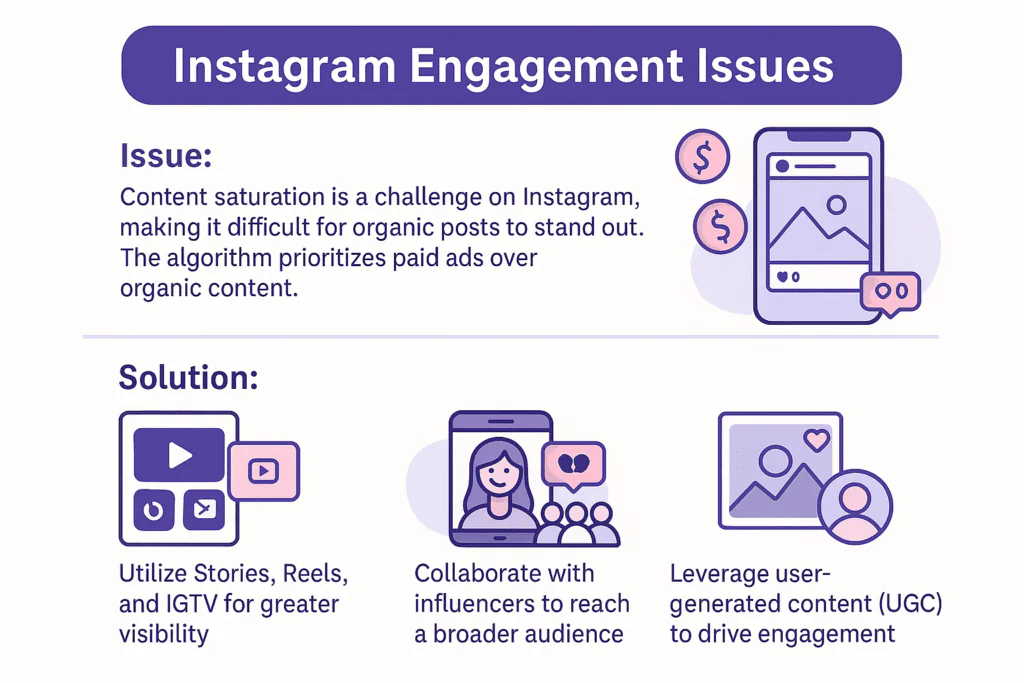
Issue:
One of the biggest challenges on Instagram today is content saturation. With millions of posts flooding the platform daily, it can be tough for organic content to stand out. Plus, Instagram’s algorithm often favors paid ads over organic posts, making it harder for businesses to achieve the same level of visibility they once had.
Solution:
To overcome this, it’s important to embrace Instagram best practices and Instagram’s diverse content formats. Instagram Stories, Reels, and IGTV are all great tools to boost your visibility. These features often get more exposure than traditional posts, so make sure to use them regularly to engage with your followers.
Another effective strategy is to collaborate with influencers. Influencers can help you reach a broader yet targeted audience. They can amplify your message and increase brand awareness, especially if they have a dedicated and engaged following that aligns with your brand.
In addition, don’t underestimate the power of user-generated content (UGC). Sharing content created by your followers not only fosters a sense of community but also encourages other users to engage with your brand. UGC gives you authentic content without the need to create it yourself.
Tip: Instagram’s new algorithm places a lot of emphasis on time spent on the platform, meaning the more users interact with your content, the better it will perform. To boost engagement, encourage your followers to participate in polls, quizzes, and challenges. These features are an easy way to get your audience involved and increase their interaction with your posts.
3. TikTok Content Creation Barriers
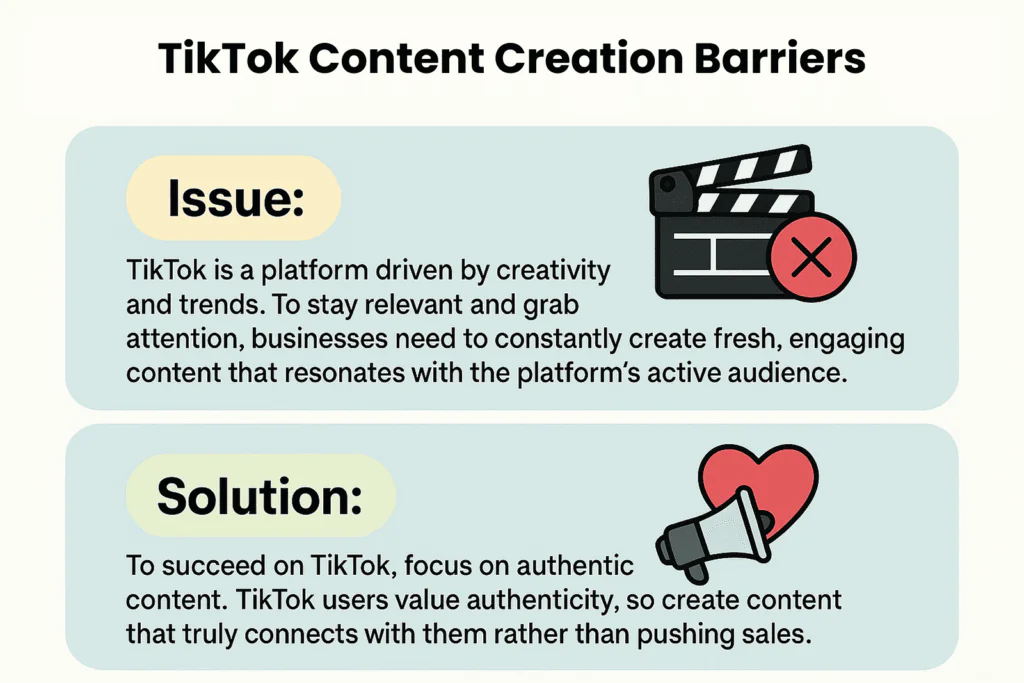
Issue:
TikTok is a platform driven by creativity and trends. To stay relevant and grab attention, businesses need to constantly create fresh, engaging content that resonates with the platform’s active audience. The challenge here is balancing the high demand for trendy content while staying true to your brand’s identity. Without the right balance, your content can get lost in the sea of videos flooding the platform every minute.
Solution:
To succeed on TikTok, focus on authentic content. TikTok users value authenticity, so create content that truly connects with them rather than pushing sales. Show your brand’s personality and share behind-the-scenes moments or fun, relatable content that aligns with the TikTok culture.
While trends are a great way to stay relevant, it’s important to add your brand’s unique voice to them. Don’t just jump on the latest trend; make it your own. By blending trends with your brand’s personality, you’ll stand out from the crowd and engage users in a more meaningful way.
If organic content isn’t driving the engagement you’d hoped for, experiment with TikTok Ads. TikTok’s paid promotion options can help you reach a larger audience quickly. Use them strategically to complement your organic efforts and boost your visibility.
Tip: TikTok’s analytics are your best friend. Dive into the performance data of your videos to see which types of content get the most engagement. Use these insights to fine-tune your strategy and post more of what your audience loves.
4. LinkedIn B2B Challenges
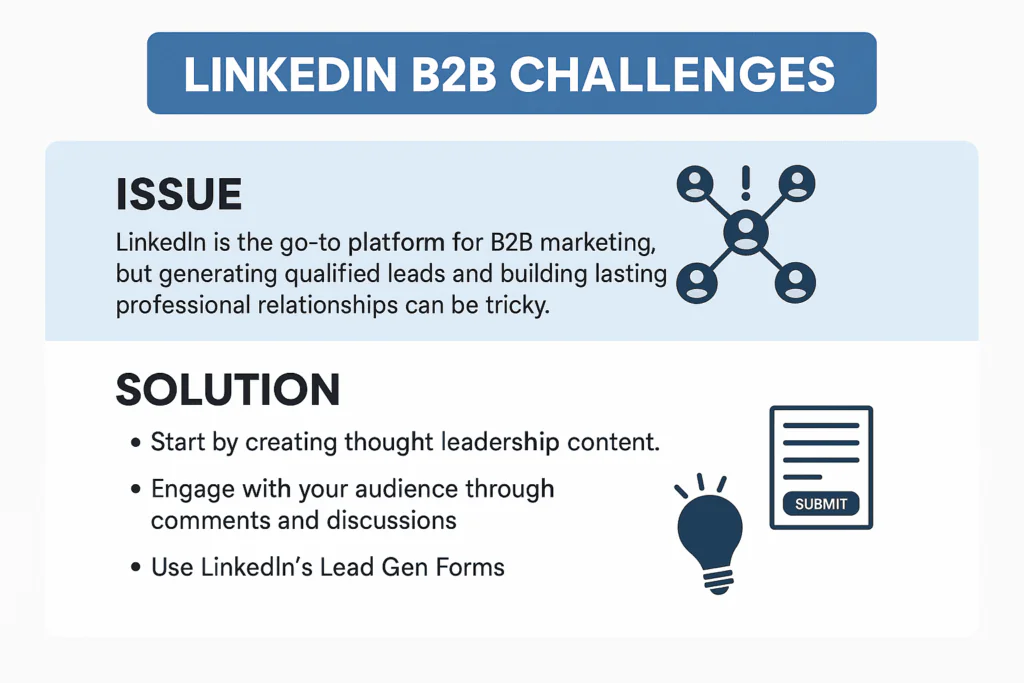
Issue:
LinkedIn is the go-to platform for B2B marketing, but generating qualified leads and building lasting professional relationships can be tricky. Unlike other social platforms, where engagement is more casual, LinkedIn’s professional networking context requires a more thoughtful approach. It’s not just about getting likes or shares, it’s about engaging the right people and nurturing those relationships over time.
Solution:
To overcome this challenge, start by creating thought leadership content. Share insights, trends, and valuable expertise that establish your brand as a trusted industry authority. By providing value, you’ll build trust with your audience, making them more likely to engage with your business and eventually convert.
Engagement is just as important on LinkedIn as it is on other platforms. Make sure to interact directly with your audience. Comment on posts, join discussions, and participate in relevant LinkedIn groups where your target audience hangs out. This will help you establish a presence and foster relationships within your industry.
Also, use LinkedIn’s Lead Gen Forms. These forms allow you to capture leads directly from your ads without redirecting users to an external landing page. It’s a seamless way to collect information from prospects who are already interested in your content.
Tip: LinkedIn’s audience appreciates high-quality articles and long-form posts. Focus on creating content that goes beyond surface-level information and provides real value. This type of content is more likely to attract and engage a professional audience that values deep insights and industry expertise.
5. Emerging Platforms (Threads, BeReal)
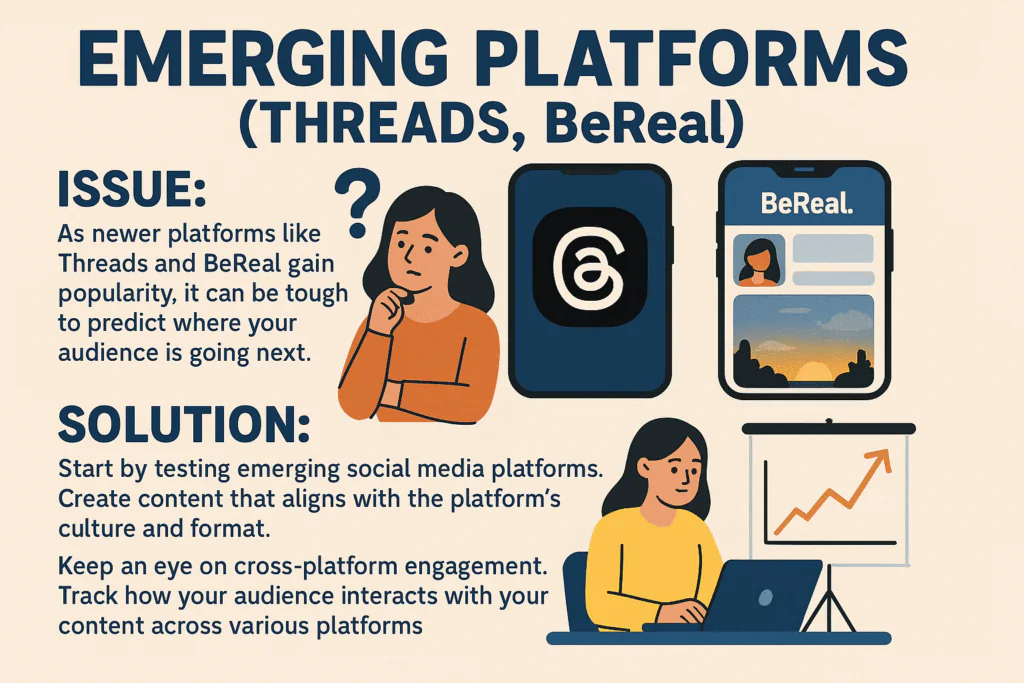
Issue:
As newer platforms like Threads and BeReal gain popularity, it can be tough to predict where your audience is going next. Audience migration is often unpredictable, and what works on established platforms may not work as well on newer ones. The challenge lies in figuring out whether to invest time and resources into these new platforms or continue focusing on the big players.
Solution:
Start by testing emerging social media platforms. Don’t just jump in without a plan; create content that aligns with the platform’s culture and format. New platforms tend to have a different vibe compared to mainstream social media, so tailor your content to fit in without feeling forced or out of place.
Keep an eye on cross-platform engagement. Track how your audience interacts with your content across various platforms. This will help you spot patterns and trends, showing you where your audience is migrating. By staying on top of this, you can adjust your strategy and ensure you’re present where your audience is most active.
Tip: When creating content for newer platforms, avoid repurposing content from other channels. Instead, focus on crafting platform-specific content that feels natural and authentic to the platform’s users. This will help you connect with the audience more effectively and build a stronger presence on these emerging platforms.
Tactical and Implementation Social Media Marketing Challenges
6. Algorithm Changes
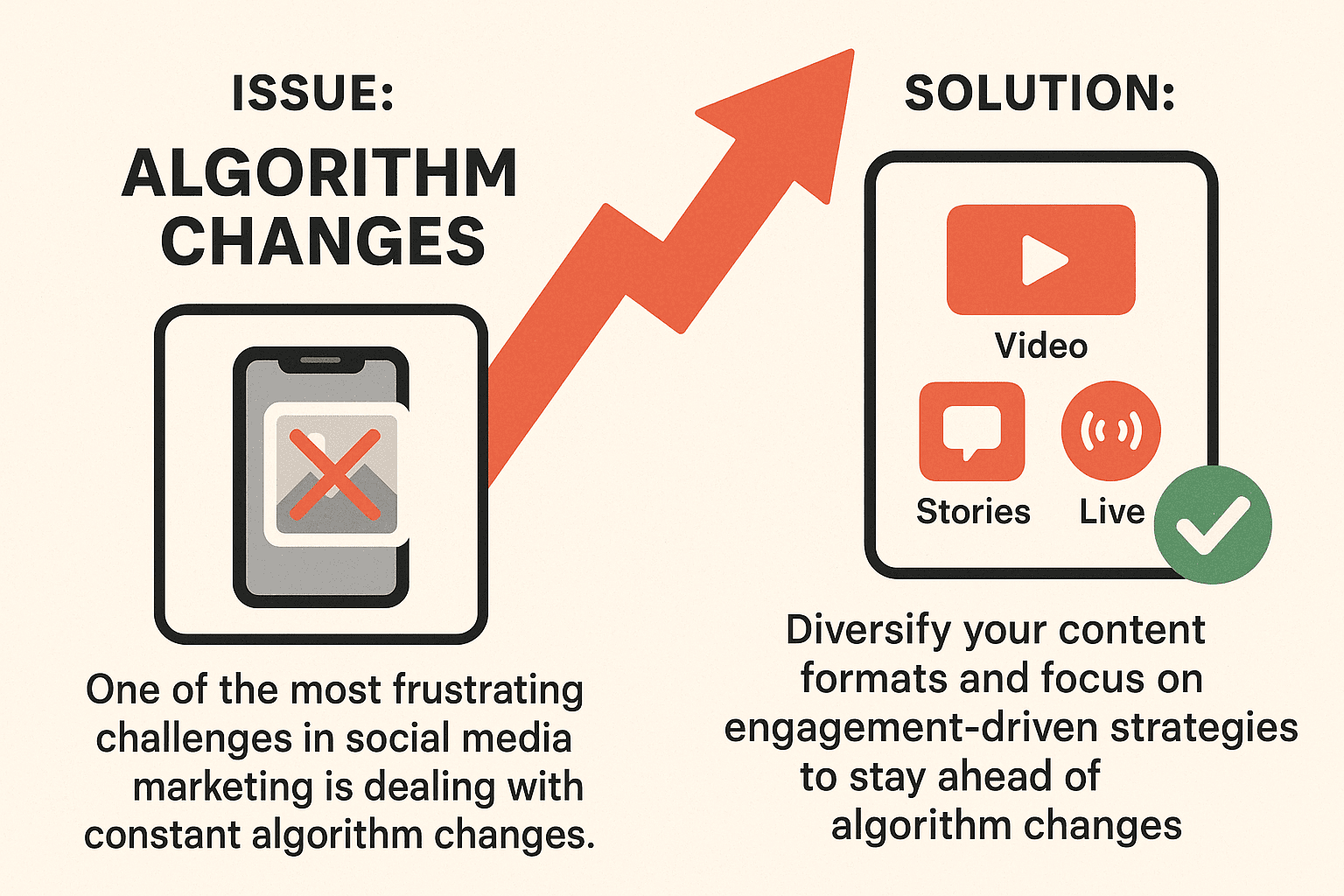
Issue:
One of the most frustrating challenges in social media marketing is dealing with constant algorithm changes. For example, Instagram’s recent shift toward prioritizing Reels has thrown off many businesses that relied on traditional posts and other formats for engagement. These sudden changes can create instability in content performance, making it difficult to predict what will work and how to get your content in front of the right people.
Solution:
Diversify your content formats to stay ahead of algorithm changes. Instead of relying on just one type of post, mix things up with videos, Stories, and live streams. These formats tend to get more visibility with algorithm updates, so by using a variety of content, you increase your chances of staying visible on users’ feeds.
Focus on building an engagement-driven strategy rather than depending solely on organic reach, which can fluctuate with algorithm updates. Make engagement and community-building your primary focus. Respond to comments, start conversations, and encourage followers to engage with your content in a meaningful way.
Tip: Stay informed on upcoming algorithm changes by following social media news sources. Platforms like Instagram, Facebook, and TikTok often announce major updates, and keeping an eye on these changes can help you adjust your content strategy in advance. This way, you can stay proactive instead of scrambling to adapt when the updates hit.
7. Content Creation Difficulties
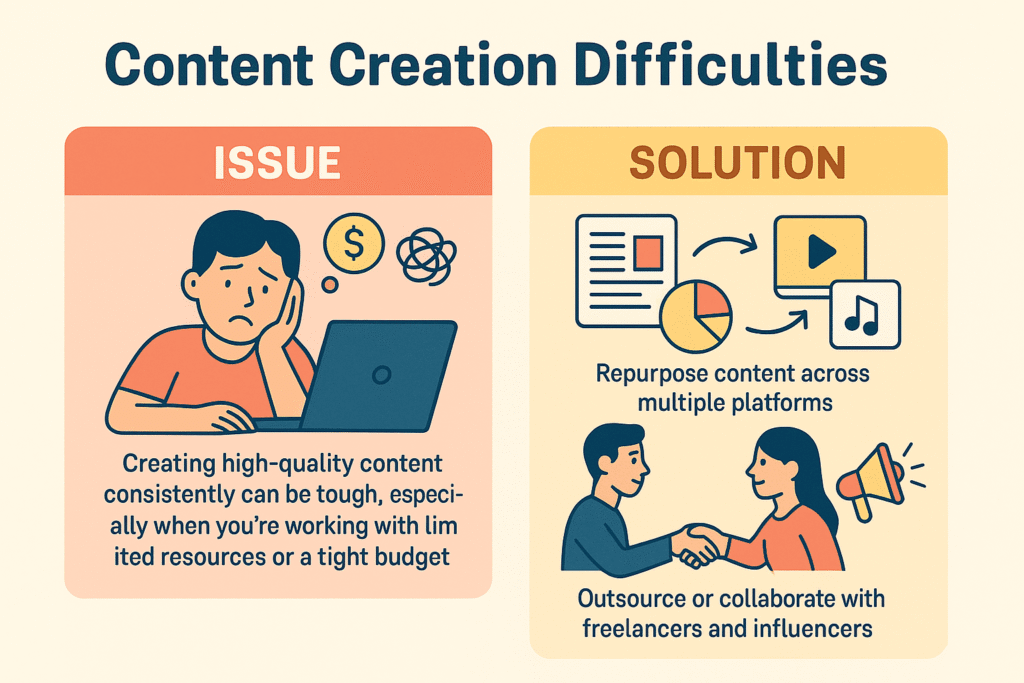
Issue:
Creating high-quality content consistently can be tough, especially when you’re working with limited resources or a tight budget. The costs of professional video production, design, or hiring a full-time content team can quickly add up. As a result, many businesses struggle to produce the amount of engaging content their audience expects.
Solution:
One way to ease this burden is by repurposing content across multiple platforms. For example, turn long blog posts into engaging infographics, or transform videos into bite-sized clips for platforms like Instagram or TikTok. This allows you to get more mileage out of your content and save time and money on creating new material from scratch.
Another great solution is to outsource or collaborate with freelancers and influencers. You don’t need to do everything in-house. Freelancers can help with design, writing, or video production, and influencers can create content that aligns with your brand, often at a fraction of the cost of a full production team.
Tip: Use content repurposing tools like Canva or RecurPost to make the most of limited resources. These tools allow you to easily create high-quality visuals and content, even without a professional design team. By repurposing content and using accessible tools, you can maintain a consistent flow of content without breaking the bank.
8. Cross-Departmental Collaboration Challenges
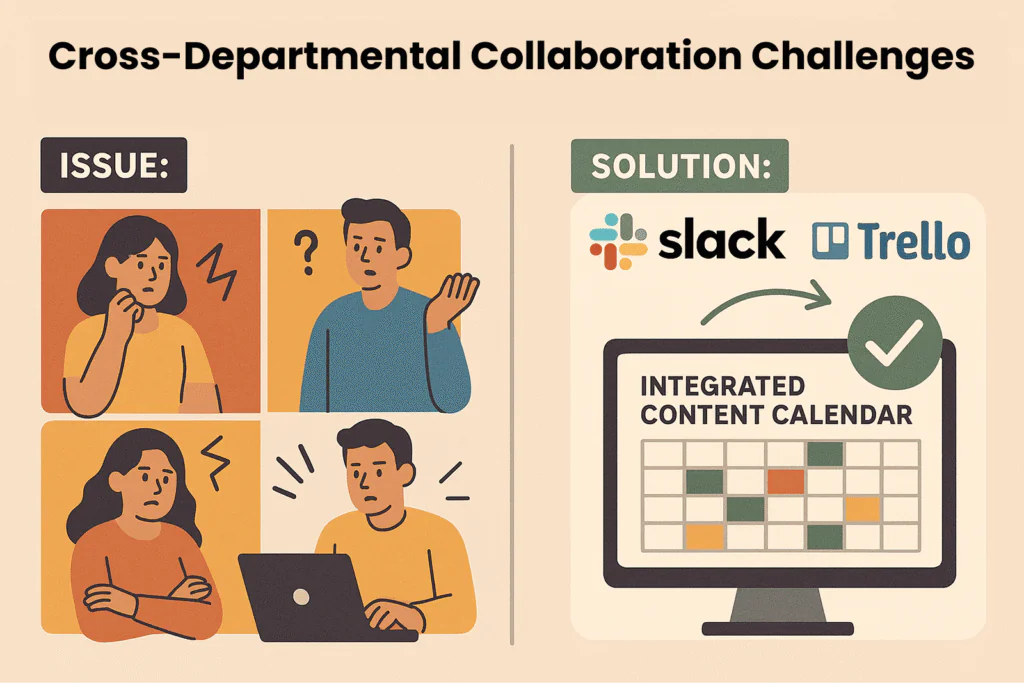
Issue:
Running successful social media campaigns often requires input from multiple teams content, PR, customer service, and others. This can lead to communication breakdowns, missed deadlines, and misaligned goals. When each department works in silos, it can be hard to ensure everyone is on the same page, which can impact the overall effectiveness of your campaigns.
Solution:
Establish clear communication channels to tackle this issue. Tools like Slack and Trello can help streamline workflows by allowing teams to communicate efficiently, share updates, and track project progress in real time. With these tools, everyone knows what’s happening and when.
Another solution is to create an integrated content calendar. This calendar will serve as a single source of truth for all teams involved, ensuring alignment on the content to be created, deadlines, and the platforms where content will be published. It also helps prevent overlap and ensures that all teams know what is expected.
Tip: Don’t wait for problems to arise; hold regular meetings to review campaign progress and discuss upcoming content. These meetings will give teams the chance to voice concerns, share updates, and stay aligned throughout the campaign’s life cycle. Regular check-ins will keep everyone moving in the same direction.
9. Resource Allocation and Team Structure
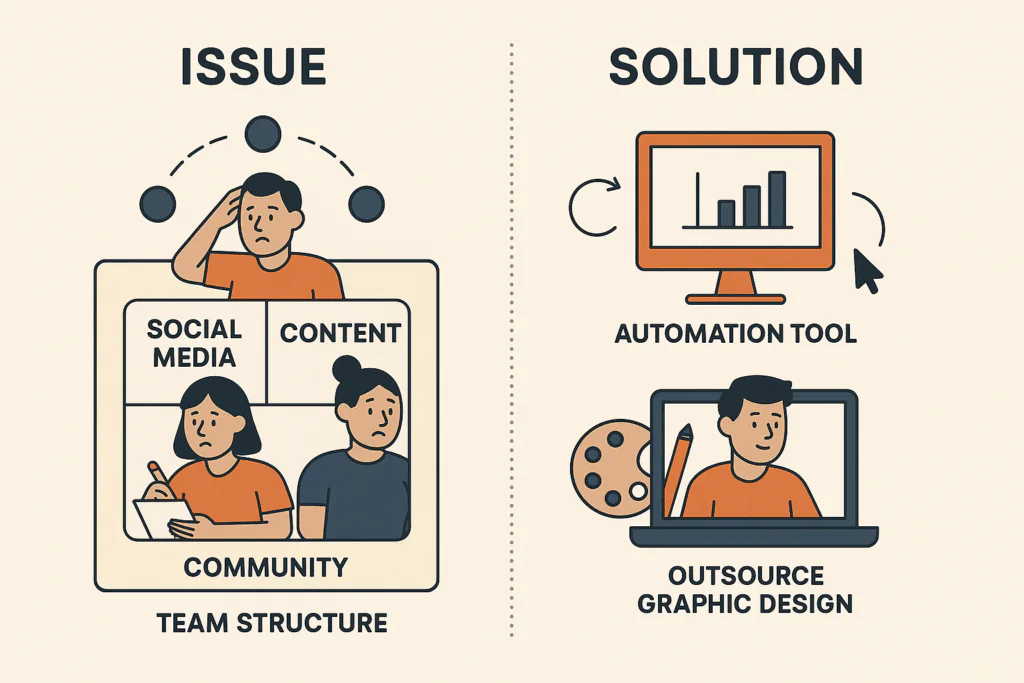
Issue:
For smaller teams, balancing social media management, content production, and community management can feel like juggling too many tasks at once. With limited resources, it’s tough to keep up with the demand for regular content while also engaging with followers and ensuring everything runs smoothly.
Solution:
One way to ease this burden is to use automation tools like RecurPost. These tools can help you schedule posts in advance, ensuring your content goes live consistently without needing to be manually posted every day. This keeps the flow of content regular without overwhelming your team with last-minute tasks.
Another approach is to outsource certain tasks, like graphic design or video production. You don’t have to handle everything in-house. By partnering with freelancers or agencies for specific tasks, you can scale your efforts and maintain quality without stretching your team too thin.
Tip: Analyze your data regularly to understand which types of content demand the most resources. If videos require a significant amount of time and energy but generate the highest engagement, allocate more resources there. This helps optimize your team’s workload and ensures you’re focusing on the most effective content.
Measuring and Proving ROI
10. ROI Measurement Challenges
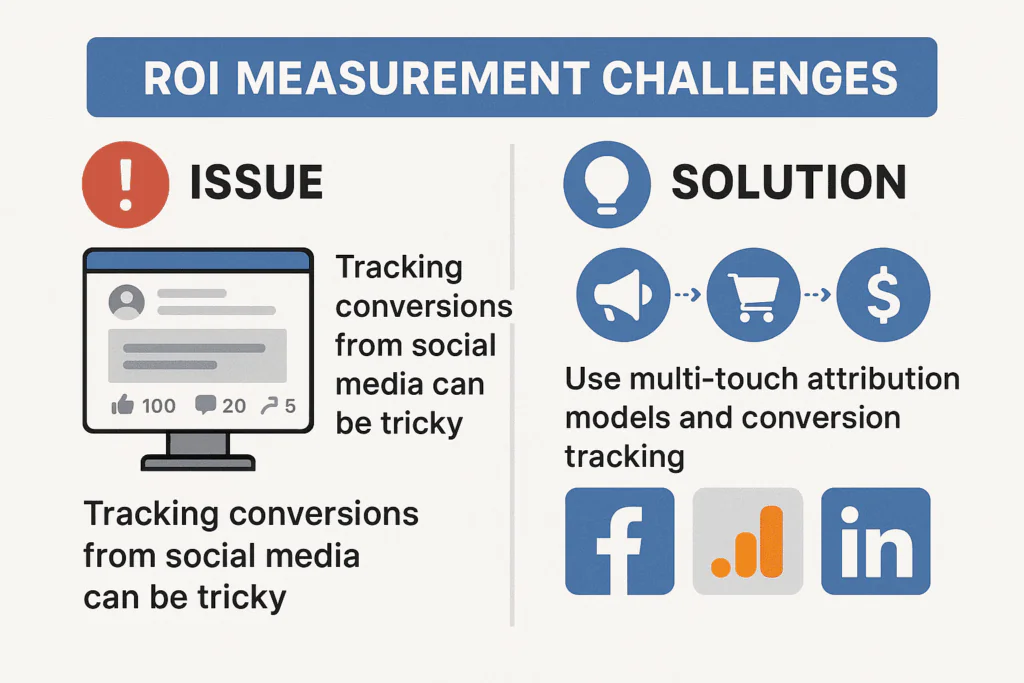
Issue:
Tracking conversions from social media can be tricky, especially when you’re running campaigns without direct sales links. It’s easy to measure likes, shares, and comments, but conversions, such as purchases or lead sign-ups, are often harder to track. Without clear data, it’s difficult to prove how well your social media efforts are paying off.
Solution:
Consider using multi-touch attribution models to better track the customer journey. These models help you track the entire path a customer takes from seeing your post on social media to making a purchase. This way, you can attribute conversions to multiple touchpoints in the customer journey, not just the final click.
It’s also a good idea to implement conversion tracking across platforms like Facebook, Google Analytics, and LinkedIn. These tools allow you to monitor specific actions, such as sign-ups or purchases, and measure how social media influences these outcomes.
Specific metrics businesses should track:
- Conversion rate (industry average: 1.5-3% from social media traffic)
- Cost per acquisition (typical range: $15-$50 depending on industry)
- Customer lifetime value attribution (social media customers typically have 15-20% higher LTV)
Tip: To get more accurate tracking of your social media campaigns, set up custom UTM parameters. These parameters will help you track which specific posts or ads are driving traffic and conversions. By adding UTM codes to your links, you can track the performance of your campaigns more precisely and adjust them as needed for better results.
11. Declining Engagement Rates
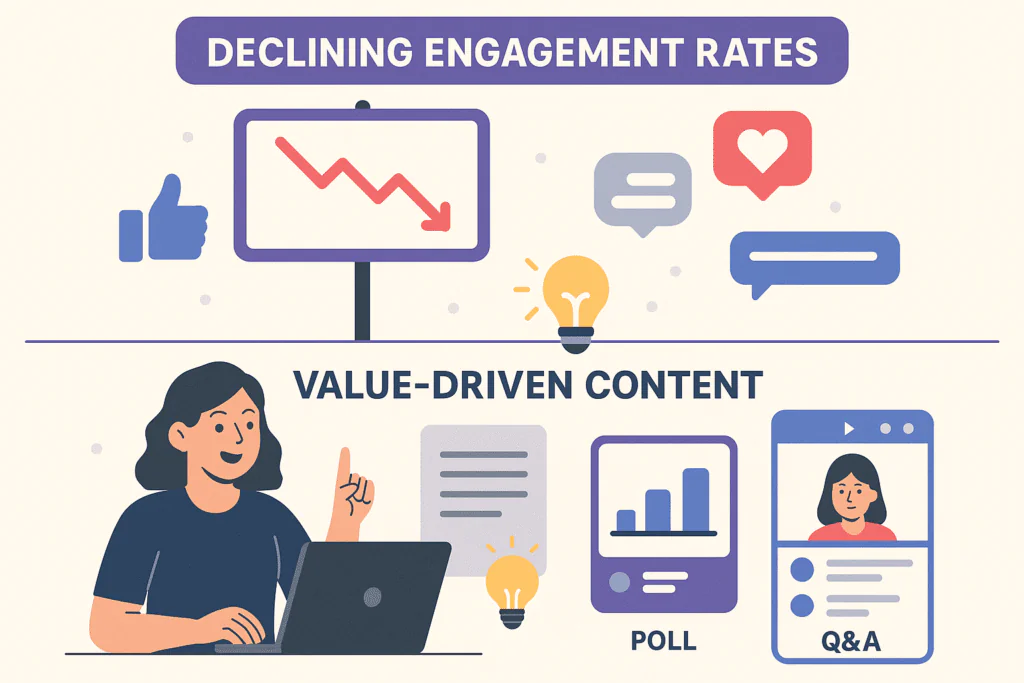
Issue:
Engagement rates are falling across most social platforms. Audience fatigue and changes in platform algorithms are making it harder for businesses to capture attention and keep users engaged. With so much content being posted every day, it’s tough to stand out, and your audience may not be interacting with your posts as much as they used to.
Solution:
Focus on delivering value-driven content that directly addresses your audience’s pain points to improve engagement. People engage with content that feels relevant to their needs, so aim to provide useful information or solutions that speak to what they care about most.
You can also re-engage your audience by using interactive content like polls, live videos, and Q&A sessions. These formats encourage more interaction and help you create a two-way conversation with your followers. It’s a great way to get real-time feedback and keep your community involved.
Tip: User-generated content (UGC) is a powerful tool for boosting engagement. By showcasing authentic customer experiences, you can tap into your audience’s desire for real, relatable content. UGC not only helps build trust but also encourages more people to interact with your posts and feel more connected to your brand.
Advanced Social Media Marketing Challenges and Solutions
12. Social Media Burnout
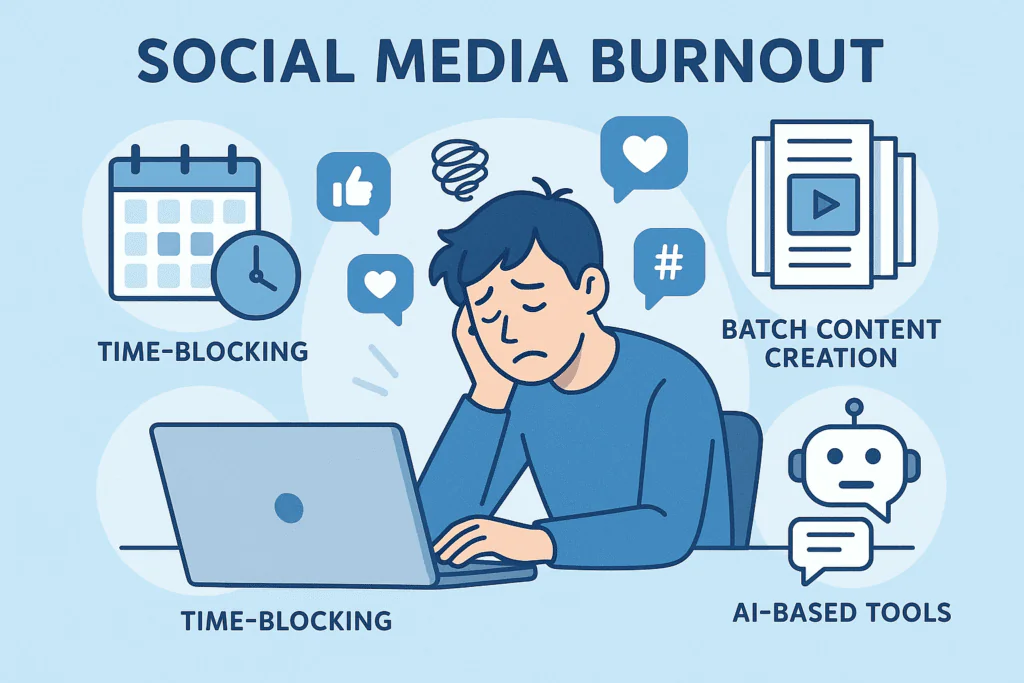
Issue:
Social media burnout is a real problem for many teams. The constant pressure to create fresh content, engage with audiences, and manage multiple platforms can lead to exhaustion. Over time, this can affect both the quality of the content and the well-being of the team members, making it harder to maintain consistent performance.
Solution:
Implement time-blocking strategies to combat burnout. Set aside specific blocks of time for different tasks like content creation, engagement, and analysis. This helps prevent the feeling of being overwhelmed by tasks piling up and keeps the workflow more manageable.
Another great strategy is to batch content creation. Instead of creating content daily, set aside a few hours each week to create several posts at once. This helps keep your social media consistent without the daily grind.
Additionally, make use of AI-based tools. Tools like chatbots for customer service or content scheduling tools can reduce the amount of manual work needed. These tools automate repetitive tasks, allowing your team to focus on higher-level strategy and creativity.
Tip: Encourage your team to take regular breaks and delegate tasks effectively. Social media management doesn’t have to fall on one person’s shoulders. Share the workload and ensure everyone has time to recharge, so your team can maintain a sustainable pace without burning out.
13. Data Privacy and Compliance
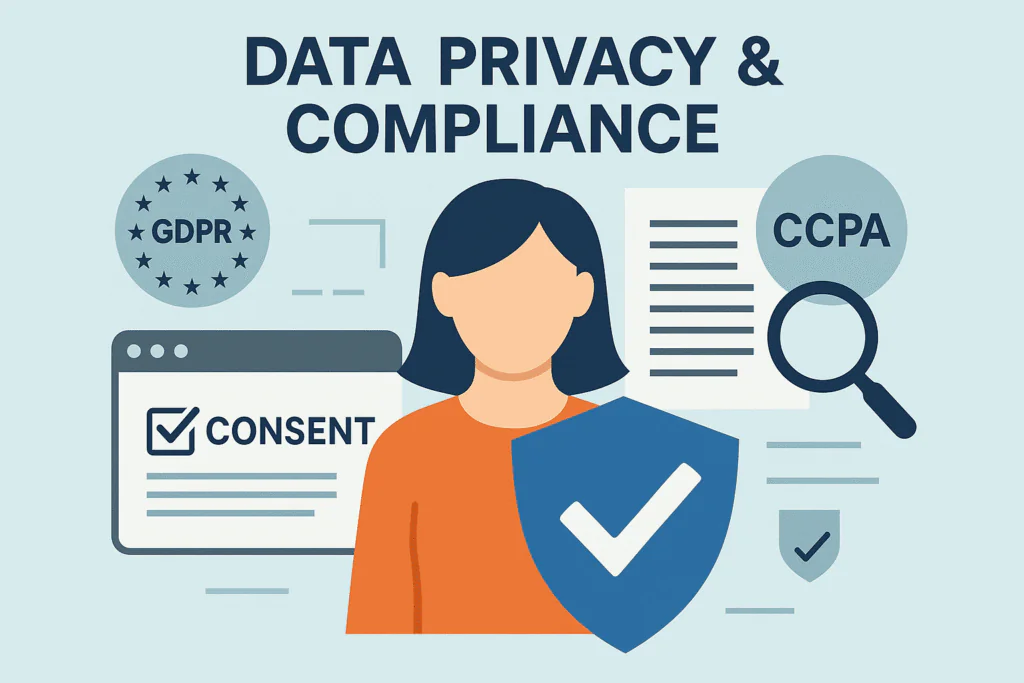
Issue:
Navigating global privacy regulations like GDPR and CCPA can make data collection and audience targeting more complicated. As privacy laws become stricter, businesses must be extra careful to ensure they aren’t violating any rules. Failing to do so can result in hefty fines and damage to your brand’s reputation.
Solution:
Make use of platform tools to manage consent and data collection to stay compliant. Many social media platforms, such as Facebook and LinkedIn, offer built-in features to help you handle user consent and manage data in line with privacy regulations.
You should also regularly audit your data practices. Privacy regulations are constantly evolving, so it’s important to keep your privacy policies updated and ensure that your data practices are in line with the latest legal requirements. Regular audits help prevent compliance slip-ups and keep your operations secure.
Tip: To be on the safe side, work with legal experts who specialize in privacy laws. They can help you navigate the complex world of international privacy standards and ensure your business is following best practices for data protection. This can save you time, money, and potential legal trouble in the long run.
14. AI and Automation Tools
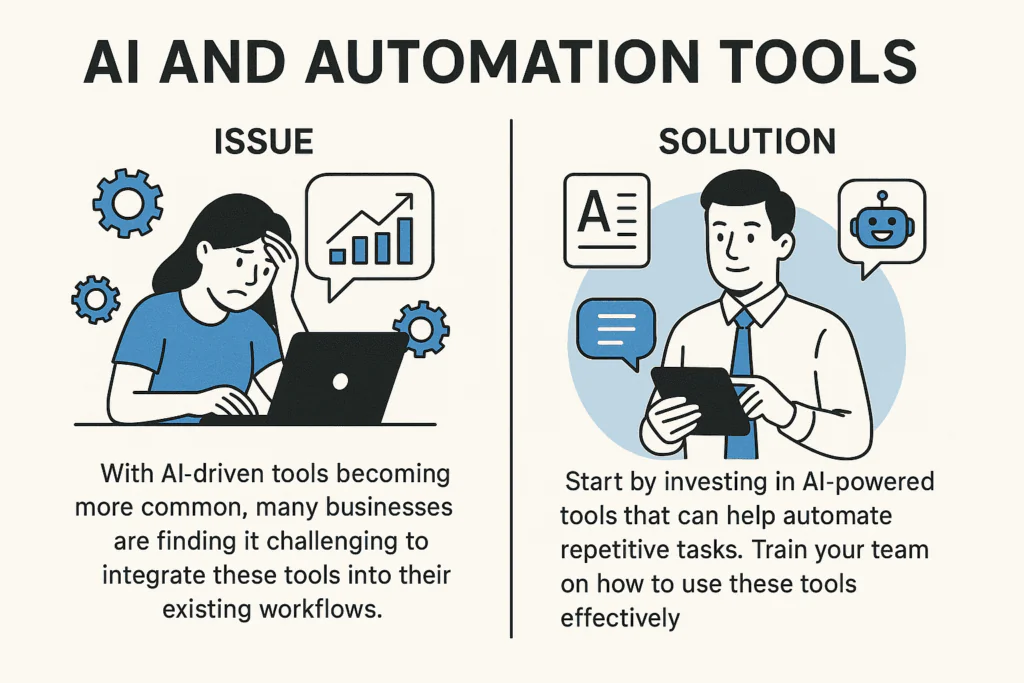
Issue:
With AI-driven tools becoming more common, many businesses are finding it challenging to integrate these tools into their existing workflows. While AI can streamline processes and improve productivity, adopting new technology can feel overwhelming, especially when it requires changes to your team’s current routines and systems.
Solution:
Start by investing in AI-powered tools that can help automate repetitive tasks. Tools like content generation software, chatbots for customer service, and social listening tools can save your team a lot of time and effort. These tools handle tasks like answering common customer questions, monitoring social media conversations, and creating simple content, freeing up your team to focus on higher-level tasks.
Another important step is to train your team on how to use these AI tools effectively. Understanding how AI can improve productivity and engagement will help your team feel more comfortable with the technology and empower them to use it to its full potential.
Tip: Start small to avoid overwhelming your team. Begin by automating routine tasks, like content scheduling, and gradually expand into more complex areas as you get comfortable with the tools. This allows your team to adjust at a manageable pace while still benefiting from the increased efficiency AI offers.
15. Short-Form Video Production Barriers
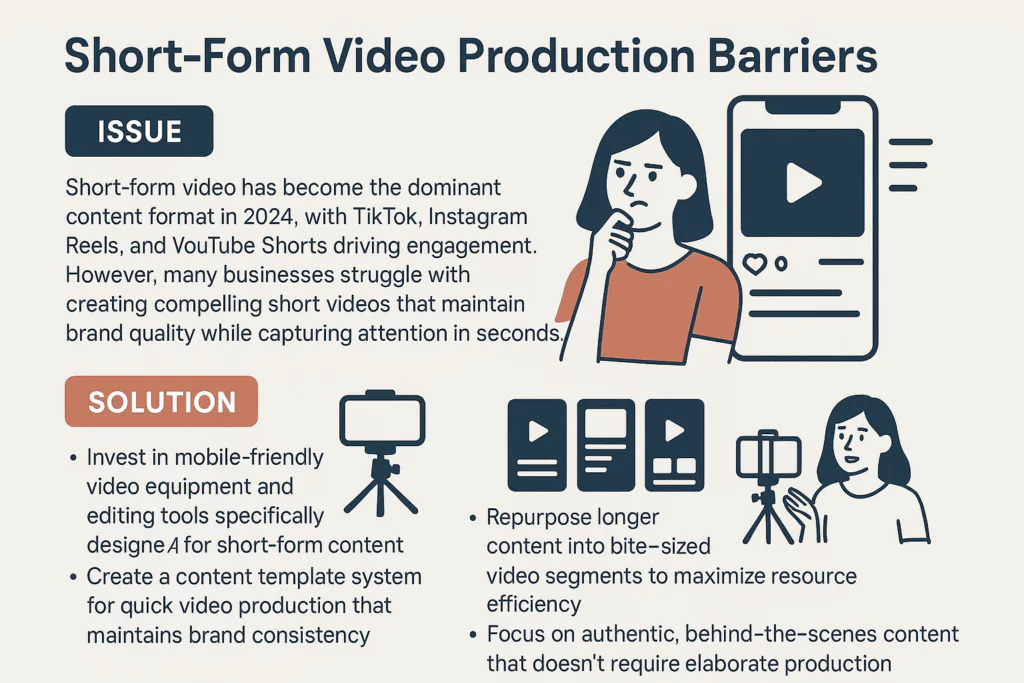
Issue:
Short-form video has become the dominant content format in 2024, with TikTok, Instagram Reels, and YouTube Shorts driving engagement. However, many businesses struggle with creating compelling short videos that maintain brand quality while capturing attention in seconds.
Solution:
- Invest in mobile-friendly video equipment and editing tools specifically designed for short-form content.
- Create a content template system for quick video production that maintains brand consistency.
- Repurpose longer content into bite-sized video segments to maximize resource efficiency.
- Focus on authentic, behind-the-scenes content that doesn’t require elaborate production.
Tip: Create a library of video templates, music, and transitions that align with your brand to streamline the production process and maintain consistency across multiple short-form videos.
16. Social Commerce Implementation
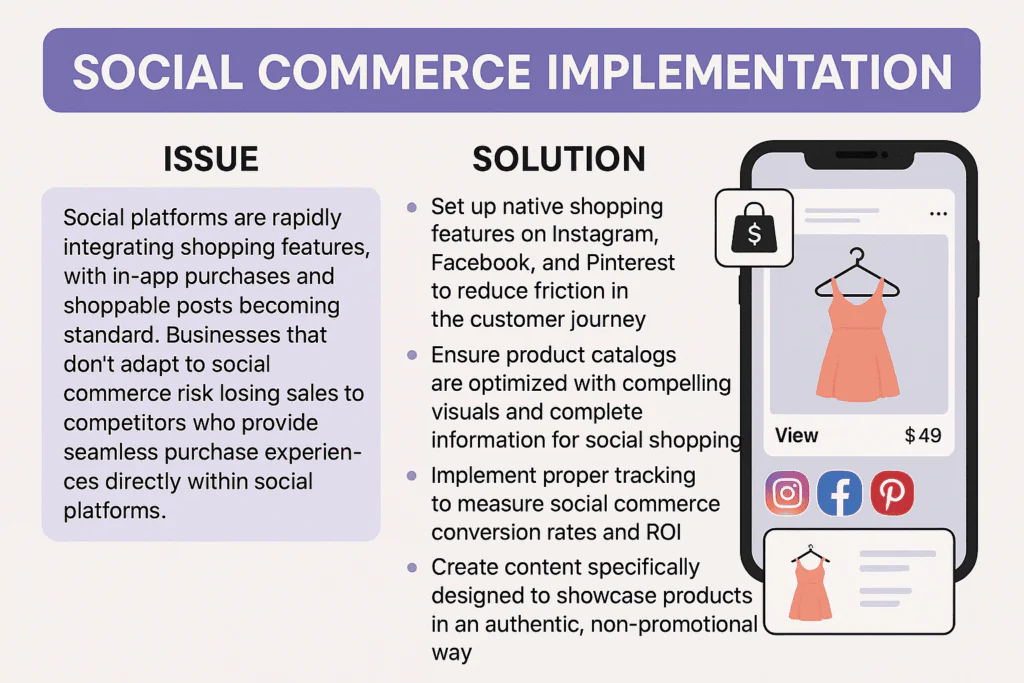
Issue:
Social platforms are rapidly integrating shopping features, with in-app purchases and shoppable posts becoming standard. Businesses that don’t adapt to social commerce risk losing sales to competitors who provide seamless purchase experiences directly within social platforms.
Solution:
- Set up native shopping features on Instagram, Facebook, and Pinterest to reduce friction in the customer journey
- Ensure product catalogs are optimized with compelling visuals and complete information for social shopping
- Implement proper tracking to measure social commerce conversion rates and ROI
- Create content specifically designed to showcase products in an authentic, non-promotional way
Tip: Test different product presentation formats to determine which drives the highest conversion rates on each platform, as shopping behaviors vary significantly across social networks.
Additional Resources
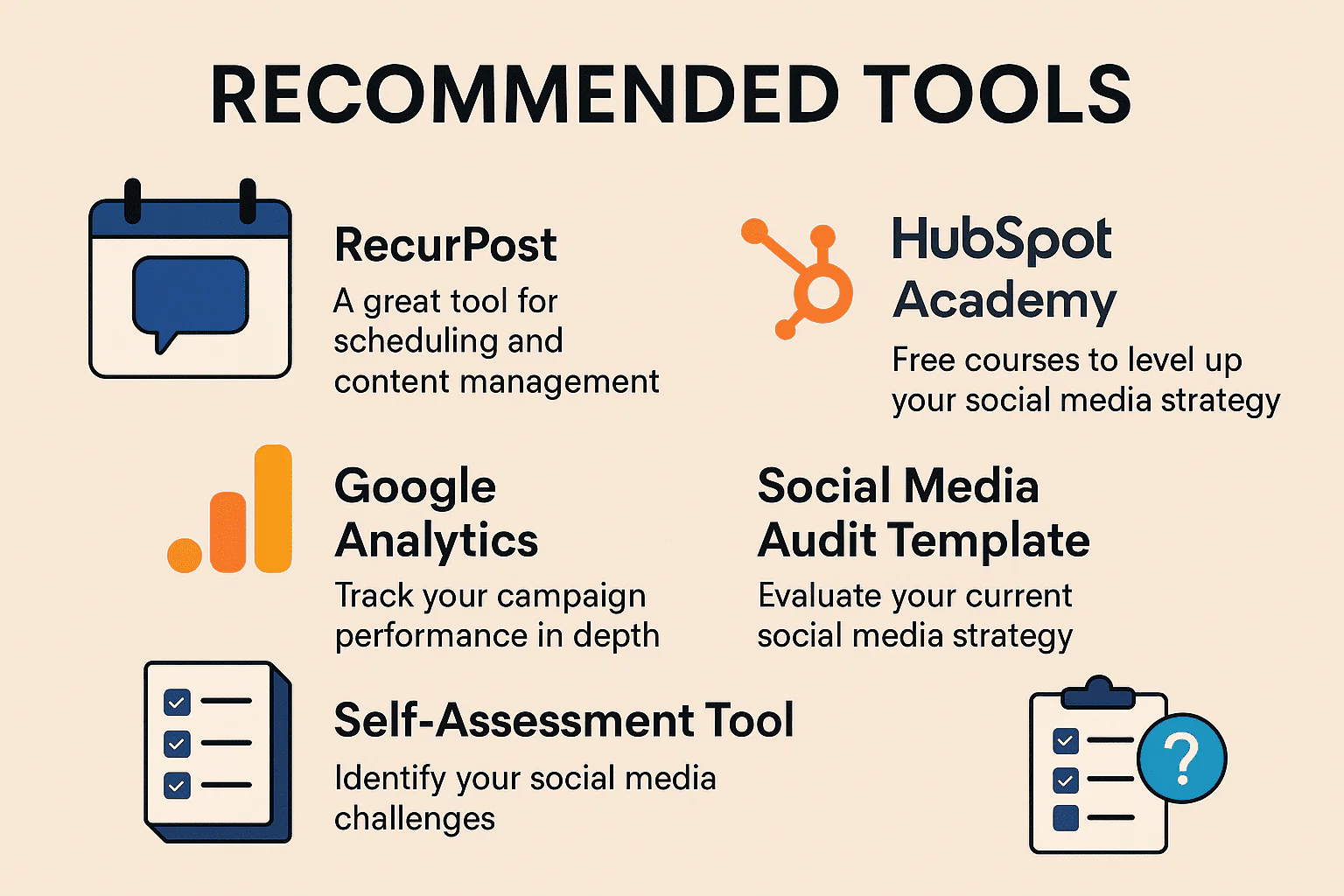
Recommended Tools:
- RecurPost: A great tool for scheduling and content management. It allows you to plan and automate your posts across multiple social media platforms, saving you time while keeping your content consistent.
- HubSpot Academy: For those looking to level up their social media strategy, HubSpot Academy offers free courses on everything from creating social media content to running ads effectively. It’s a fantastic resource to help sharpen your skills.
- Google Analytics: If you want to track your campaign performance in depth, Google Analytics is a must. It helps you understand your audience, measure conversions, and see how your social media campaigns contribute to your overall business goals.
Social Media Audit Template:
To help you evaluate your current social media strategy, we’ve created a simple template. This template will guide you through assessing your platforms, engagement, content types, and overall performance. It’s a great tool to identify strengths, weaknesses, and areas of improvement.
Self-Assessment Tool:
We’ve also included a brief questionnaire to help you identify your most pressing social media challenges. Whether it’s engagement, content creation, or algorithm issues, this self-assessment tool will give you clarity on where to focus your efforts and tackle the most critical problems first.
Conclusion
Looking ahead to 2025, businesses should prepare for increased integration of AR/VR elements in social media, further privacy restrictions affecting targeting capabilities, and the continued rise of niche social platforms catering to specific demographics.
Understanding the obstacles of social media marketing is the first step toward overcoming them. Staying on top of platform-specific issues, content creation struggles, and measuring ROI requires a proactive approach.
By using the right tools, staying informed, and adapting to changes, you can keep your social media strategy strong and effective. Keep experimenting, stay engaged with your audience, and most importantly, don’t be afraid to pivot when necessary. Success in social media marketing is all about adapting and evolving, so keep pushing forward!
Frequently Asked Questions
1. How can I increase engagement on my social media posts?
To increase engagement, focus on creating content that resonates with your audience. Use interactive features like polls, quizzes, and live videos to encourage participation. Consistently engage with comments and posts, and experiment with different content formats like Stories or Reels to boost visibility.
2. What are some tools for managing social media campaigns?
Some popular tools for managing social media campaigns include RecurPost for scheduling, HubSpot Academy for learning strategies, and Google Analytics for tracking performance. These tools can help streamline your efforts and ensure your campaigns are running smoothly.
3. How do I measure the success of my social media marketing?
To measure success, track key metrics like engagement rates, conversions, and website traffic using tools like Google Analytics and platform-specific insights. Use multi-touch attribution models to track the full customer journey and adjust your strategy based on what works.
4. What are some common mistakes in social media marketing?
Common mistakes include not understanding the platform’s algorithm, not engaging with your audience, relying too much on organic reach, and failing to track ROI. It’s also crucial to avoid inconsistent posting and neglecting to adapt to changes in platform policies or user behavior.
5. How do I handle negative comments or feedback on social media?
Address negative comments professionally and promptly. Acknowledge the issue, offer a solution or explanation, and take the conversation offline if necessary. Negative feedback, if handled well, can strengthen your brand’s reputation and build trust with your audience.
6. What is the role of influencers in social media marketing?
Influencers can help boost brand visibility and credibility by reaching targeted audiences. They provide authentic content that resonates with their followers, which can increase trust and drive engagement. Collaborating with the right influencers can amplify your message and expand your reach.
7. How can I adapt to algorithm changes on social media platforms?
Stay flexible by diversifying your content formats, focusing on engagement-driven strategies, and tracking how changes impact your reach and performance. Keep an eye on updates from social media platforms and use analytics to adjust your content strategy to align with new algorithms.
8. How can I ensure my social media campaigns are compliant with privacy regulations?
Ensure compliance by using platform tools for consent management, regularly auditing your data practices, and keeping privacy policies updated. Consulting with legal experts can help you navigate complex regulations like GDPR and CCPA to avoid any legal issues.
9. What are the best ways to repurpose content across social media platforms?
Repurpose blog posts into infographics or videos, turn webinars into bite-sized clips for social media, and share user-generated content. This saves time and helps you get the most out of your content by adapting it for different platforms.

Saurabh Chaturvedi is a content writer at RecurPost. Specializing in social media management and marketing, Saurabh is dedicated to crafting engaging and informative articles. His passion for clear, exciting content keeps readers eager for more.
